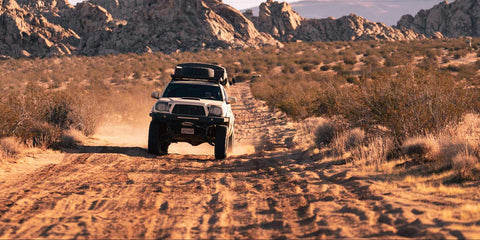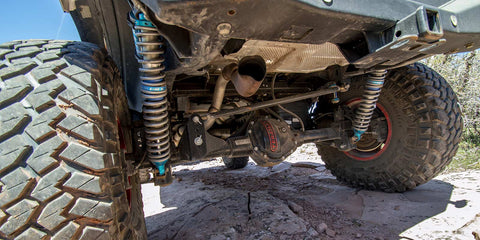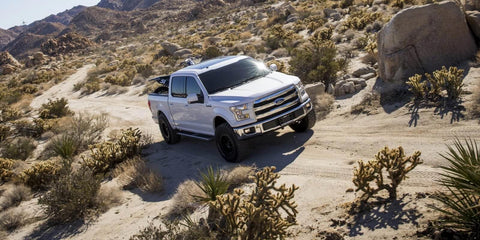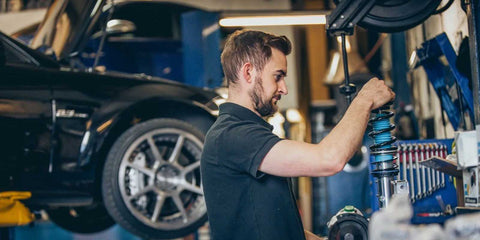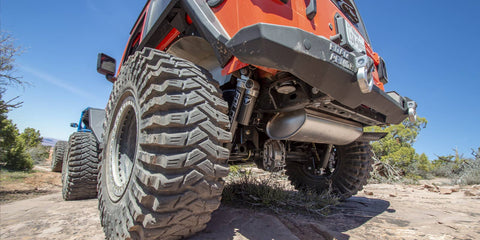How Much Should You Lift Your Truck?
Posted by Brandon Sevestre on
In This Article
As the "lift" name implies, suspension lifts increase the height of your vehicle. This allows for more ground clearance, but we think the real benefit comes from the potential for more total suspension travel - or at least a better split between up and down travel for your given use case... not to mention; the ability to run better dampers and springs that ultimately can improve comfort and control both on and off the road.
We are Shock Surplus, not Lift Surplus, because we truly believe lift height is just an ancillary benefit to an upgraded suspension system. If you just need more clearance, grab a set of bigger tires and send it, but if you want better ride quality, more travel, and more control out on the trail, upgrading your suspension should be your priority. How much lift you choose to go with or compromise for comes down to a number of factors. Although there is sometimes a ‘best height’ for select applications, our recommendations for the right height for optimal performance come down to the vehicle itself and, specifically, its suspension design and how you are using it.
Things To Consider
Focus on improving suspension performance by increasing travel, maximizing travel range, and upgrading your dampers and/or springs first. Determining these factors will help create initial guidelines for your ideal lift height.
Suspension design largely dictates how much lift you can and should do. Knowing what you have will, at the very least, create an upper threshold of how much lift is recommended based on your budget or the inherent limitations of the suspension design.
Taller lift heights allow for more upward suspension travel, while lower lift heights allow for more downward travel if total available travel remains the same. The optimal split between upward or bump/compression travel and downward or droop/rebound travel and, therefore, your approximate ideal lift depends on how you are using your vehicle.
How Much Lift Is Too Much Lift?
Less is more. Do as little lift as possible and as much as necessary.
More lift will increase your center of gravity and decrease stability. Although there are many components that can help correct geometry and reduce unwanted body motions, you can’t beat physics.
Your budget might set your limit. The more lift or more travel you try to run, the more additional parts besides your shocks and springs or coilovers are required to make the package work without bind and with proper alignment. That means more $$$.
Independent Suspension (Double A-Arm)
Independent suspension systems have a clearance advantage over solid axle vehicles at ride height, so less lift is required specifically for additional ground clearance.
Big travel gains are harder to come by than solid axle vehicles, so it is critical to maximize your limited available travel range for optimal performance for how you plan on using the vehicle.
Because travel is harder to come by, maintaining droop travel while increasing lift height is a delicate balancing act that is usually best handled by keeping your lift as low as possible while still meeting your bump travel goals.
Most independent suspension vehicles come with a standard torsion bar or coil-over strut suspension, so adding small amounts of lift is very easy with a set of torsion keys and longer shocks or a set of ride height-adjustable coilovers or struts. These systems usually have a window of ride height and therefore travel split adjustment.
Most applications can usually handle about 2-2.5” of lift with all stock components outside of the components generating the lift. Taller than that will require aftermarket upper control arms to prevent binding and correct alignment and geometry to get closer to the factory specs.
Aftermarket upper control arms allow for more travel and correct geometry/alignment, allowing most applications to go as tall as 3-3.5” of lift. Some longer-travel coilover or shock packages may require these arms to prevent bind, even if you are not doing that much lift.
Drop Bracket Lift Systems
Taller lift heights (usually 4”+) require drop bracket systems that lower your differential and lower control arm mountain locations to correct geometry, eliminating most of the clearance gained from the additional lift. Many of these kits require cutting or trimming on the stock frame crossmember making reverting back to stock or a more basic lift system often not feasible or at the very least not reasonable to do.
Total travel is ultimately limited by the length of the control arms, driveline, and steering components, not lift height or shock length, so although taller, these systems do not offer any travel benefits.
Since these systems are detrimental to performance in several ways, many of the companies that make these kits are not necessarily concerned with making a package that performs. Although geometry should be better considering all the components they space out to get back into their ideal operating range, these kits frequently have worse bump steer and camber gain than many more basic mid-travel lift systems.
Although there are likely select situations and applications that might benefit from a drop bracket system, unless you are looking at something like a Blazeland Mega Travel kit, we highly recommend keeping it lower and simpler with a higher-performing basic coilover and control arm or ‘mid-travel’ suspension package.
Solid Axle (Linked with Coil Springs)
Solid Axle suspension systems are much simpler than independent systems making it easier to get more lift and travel while correcting geometry accordingly and, in some cases, more beneficial to do so as well.
Since gaining more travel with more lift is easier to do our primary goal here is to increase travel as much as possible given our budget and the travel range required for our given use case.
Because your complete suspension and driveline assemblies all hang below the frame and body rather than pivoting around it on a solid axle application, so available bump travel will always be limited at stock ride height, making going with more lift often required to achieve your bump travel goals.
Most solid axle vehicles run their springs separate from their shocks, meaning different length shocks are available based on lift height.
Taller lifts require longer shocks, which usually have more travel. However, factors like control arm/driveline length, range of motion, and packaging will ultimately limit the maximum amount of travel and, therefore, lift that is worthwhile in a given application. Our ideal shock length and, therefore, lift height are usually determined based on finding the longest travel option before the point of diminishing gains that will work with a complete lift package we can afford.
Although most geometry and driveline correcting modifications are usually listed for certain lift heights, total travel is just as much, if not a bigger piece of the puzzle. If your suspension extends as far as somebody with a lower lift than you due to longer travel shocks, you will need the same modifications as your compatriot with less lift to make your system work properly.
Recommended lift heights for a given shock length are largely a suggestion to keep the shock in a safe operating range. If your spring package allows for a longer travel shock meant for a taller lift, and you keep the shocks safe with the appropriate length or spaced bump stops while maintaining an ideal travel range for the way you use your vehicle, or vice versa, you are good to go.
Travel Range Relative To Use Case
As you might have started catching on to, travel or your split of upward or bump and downward or droop travel is the primary driving factor around choosing a particular lift height. How you use it will be one of the final factors dictating how much bump or droop travel you need to get the job done. Somebody on lower-speed technical trails or rock crawling will want as much droop travel as they can get, while somebody going fast will want to get the most bump travel without too much compromise in either direction in both respects. Alternatively, somebody who might do a little bit of both or still has to drive their rig to work every day might fall somewhere in the middle. More often than not, concessions in bump or droop travel will have to be made, but here are a few rules we like to follow to come up with the best compromise based on the most common use cases or ‘build types’ we see.
Technical Trails/ Rock Crawling
Increasing articulation is our primary goal when building a lift kit for better low-speed off-road performance, and the best way to gain articulation is with more droop travel.
In most cases, a system that has more droop travel usually has less lift, however being too low will mean you do not have enough ground clearance or might be limited on bump travel.
Although increasing droop travel is the absolute priority here, some up travel is still required for the suspension to work on and off-road.
Our absolute minimum bump travel number is 4”.
For vehicles with less than that much bump travel from the factory lifting it to achieve 4” bump travel is highly recommended, even at the expense of droop travel.
For vehicles with more than 4” of bump travel from the factory, we recommend choosing a lift height and shock package that allows you to either retain the same amount of bump travel stock or, if it increases bump travel, allows you to have a 40-50: 50-60 percent split in bump and droop travel respectively.
Heavier vehicles like full-size trucks may require more bump travel, but this can be mitigated by larger body/higher damping force shocks.
High Speed Off Road/Sand/Prerunning
Most of the energy and forces from big bumps are absorbed by the compression stroke of your suspension. Although a lot is done on rebound or extension, maximizing bump travel is our primary goal on a go-fast rig.
Ideally, you should be shooting for a lift package that allows for 6” or more of bump travel which usually requires more lift.
Although bump travel is the priority, you need at least ~3” of droop travel. If you are unable to achieve 6” or more bump travel without maintaining at least 3” of droop travel, then it is better to sacrifice some bump travel by running less lift to maintain our minimum recommended droop.
If you have an application that can easily exceed 6” of bump travel while maintaining 3” or more droop travel, then going for a lift that sets you up with a 60-70:30-40 percent split on bump and droop travel while still keeping while still making considerations to maintain decent handling.
Rough tracks often have as many bends as they do bumps, so maintaining stable handling characteristics is more important here than anywhere else. Although going taller might allow you to run more bump travel, it will also make the vehicle more unstable and harder to point where you want it. Even though you might be able to exceed 6” of bump travel with plenty of droop travel with more lift, staying lower might pay greater dividends out in the real world.
Suspension is not the only place where you can increase your overall height and, therefore, center of gravity. When making your choice on a lift, make sure to account for tire size, body lift, and weight above your roofline. Any increase in COG will reduce stability, so keeping it lower on suspension lift when you have other modifications that make your vehicle taller or raise its COG is always a good idea.
Mixed Driving
For mixed driving usage, your travel range needs usually fall between a strict rock crawler and Prerunner.
The more travel, the better, especially here, but we find 5” to be a safe minimum for bump travel and 3” to be the same minimum for droop.
If sacrifices need to be made, it will inherently be better to sacrifice some bump travel as long as you can run at least 3” of droop.
For vehicles with more than 8” of total travel a 50-60:40-50% split between bump and droop travel is usually optimal.
Mall Crawling
The taller you lift your vehicle, the worse it will perform on the street, so we recommend the minimum lift possible to meet your stance, height, and tire size goals.
Wheel gap is the enemy of good-looking fitment, so lower lift and bigger tires is always better.
Travel range is less of a concern. As long as you can retain the same amount of bump travel as stock and have at least 3” of droop you are good.
Tire Clearance - Vertical Clearance - Inboard/Outboard Clearance - Fore/AFT ClearanceLift height does not directly equate to tire clearance unless you limit bump travel accordingly.
Increasing lift height and limiting travel accordingly can usually only assist with vertical clearance. Clearance inboard and outboard or fore and aft of the tires can mostly only be gained by changing your wheels, axles, or arms to alter track width or running adjustable control arms to make minor alterations to wheelbase.
Our primary goal when looking for more tire clearance is to do enough lift to get us to our ideal travel range for our given use case or at least allow us to maintain the same amount of bump travel as stock while accounting for the amount we need to limit upward travel.
Ex: If your vehicle has 4” of bump travel stock, and you need 2” more vertical tire clearance, if you did a 2” lift with a 2” bump stop spacer or longer bump stop, your tires should clear, and you should be able to maintain at least the same amount of bump travel as stock. Any lift above that would be primarily done to help you gain more bump travel for your given use case.
Leveling Kits
Benefits
Leveling your vehicle helps generate a more even weight distribution front to rear.
A more balanced F/R weight split improves handling below and above the limit (less brake dive and roll, more neutral handling balance overall).
Many vehicles are over sprung and damped in the rear and under sprung and damped in the front. Shifting weight rearward in the chassis can help make the front feel more supportive and the rear less jittery.
A more even rake and weight distribution can aid in your front suspension being able to frequency skim or skip over the top of successive big bumps at speed.
Many vehicles have more travel in the rear than in the front, and running a leveling kit can help even out total travel numbers as well as the travel split between bump and droop travel.
Drawbacks
Vehicles come from the factory with a rear high rake to aid with towing and hauling while still being at least somewhat drivable when unloaded.
Starting off level will make it that much easier for your rear suspension to sag below the front thus lessening your braking and steering performance.
If you are planning to continue to tow/haul from time to time after leveling your truck, adding on a load leveling upgrade like SumoSpring and Timbren SES Bump stop kits or air bags is highly recommended.
It is difficult to have as much bump travel in the rear as your vehicle does in the front if it has been leveled and has IFS and a solid rear axle. For high-speed off-road use it is important to have the same if not more bump travel in the rear, so although being level can help the front end skim through chop, it is often required to lift the rear a bit to keep it from bottoming out and bucking.
On IFS/SRA applications, articulation is often greatly improved by adding lift to the rear to maintain or increase rake. It is easier to get more total travel from a solid axle just by adding lift and longer shocks, and having some rake to ensure your weight bias is front-heavy will aid in forcing your flex averse IFS to articulate more.
Conclusions
Key Factors for Lift Height Decisions:
- Performance: The primary goal should be performance, with lift height as a secondary consideration.
- Suspension Design: Understanding your vehicle's suspension is crucial for setting lift guidelines.
- Independent vs. Solid Axle: Independent suspensions generally offer more clearance, but solid axles are easier to lift and get more travel.
- Travel and Articulation: Lift height affects droop travel and, therefore articulation, especially for independent suspensions. Less lift means more droop and more lift means more bump.
- Drop Brackets: Avoid drop brackets if possible to maintain clearance.
- Streetability and Budget: Balance lift height with ease of driving and cost considerations.
Recommendations for Lift Height:
-
Independent Suspensions:
- Stay below 4” to avoid drop brackets.
- Use lower strut/torsion key/coilover settings for more droop travel.
-
Solid Axles:
- Lift and travel can be added simultaneously up to a point, however there are diminishing returns in travel after a certain height on most applications.
- Consider limitations in bump travel and handling.
- Balance lift height with drivability and budget.
Travel Considerations:
- Droop Travel: Prioritize for low-speed trails, but maintain some bump travel.
- Bump Travel: Prioritize for higher-speed off-roading.
- Vehicle Weight and Wheelbase: Heavier and longer vehicles may require more bump travel and lift.
-
Minimum Recommendations:
- At least 4" bump wheel travel for crawling.
- 6" or more bump travel for go-fast builds.
- No less than 3” of droop travel regardless of use case
Additional Considerations:
- Vehicle Stability: Avoid excessive lift height to maintain stability and control.
- Personal Preference: Ultimately, lift height is a matter of personal choice based on your needs and driving style.














